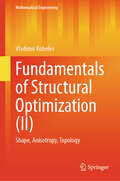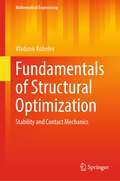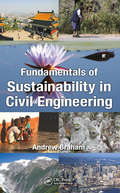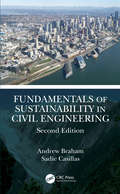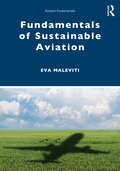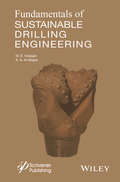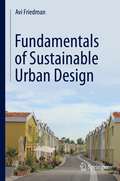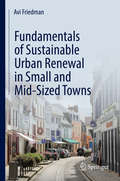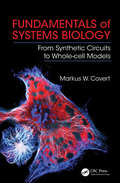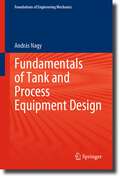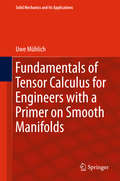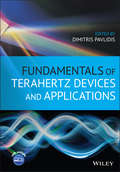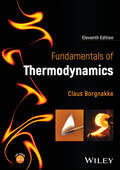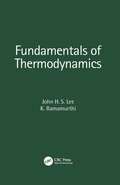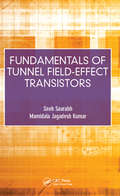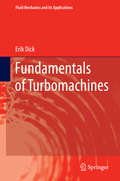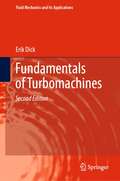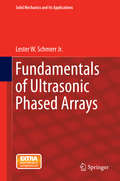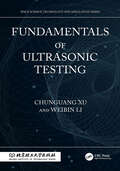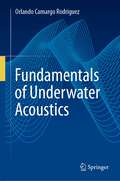- Table View
- List View
Fundamentals of Structural Optimization: Shape, Anisotropy, Topology (Mathematical Engineering)
by Vladimir KobelevThis book provides a comprehensive overview of analytical methods for solving optimization problems, covering principles and mathematical techniques alongside numerical solution routines, including MAPLE and MAXIMA optimization routines. Each method is explained with practical applications and ANSYS APDL scripts for select problems. Chapters delve into topics such as scaling methods, torsion compliance, shape variation, topological optimization, anisotropic material properties, and differential geometry. Specific optimization problems, including stress minimization and mass reduction under constraints, are addressed. The book also explores isoperimetric inequalities and optimal material selection principles. Appendices offer insights into tensors, differential geometry, integral equations, and computer algebra codes. Overall, it's a comprehensive guide for engineers and researchers in structural optimization.
Fundamentals of Structural Optimization: Stability and Contact Mechanics (Mathematical Engineering)
by Vladimir KobelevThis book serves as a complementary resource to the courses "Advanced structural optimization" and "Structural optimization in automotive engineering" taught by the author at the University of Siegen, North-Rhine-Westphalia, Germany since 2001. Focusing on optimization problems in the field of structural engineering, this book offers a rigorous and analytical approach to problem-solving. Each chapter of the book begins with a brief overview of classical results and the derivation of governing equations. The solutions to optimization problems are then presented in a closed form, with the author guiding readers through several analytical methods for solving stability and contact tasks. Throughout the book, the author takes care to ensure that even readers without extensive experience in numerical computations can understand the conclusion of each relation. The book features several basic optimization problems, selected from a large pool of previously solved problems, with a particular emphasis on the unique features of optimization problems. By presenting analytical solutions, readers can better understand other known optimization problems and gain the skills needed to independently set and solve new problems. With its comprehensive and rigorous approach to problem-solving, this book is sure to enhance the reader's understanding of the field and equip them with the skills needed to tackle new challenges.
Fundamentals of Sustainability in Civil Engineering
by Andrew BrahamThis book will provide a foundation to understand the development of sustainability in civil engineering, and tools to address the three pillars of sustainability: economics, environment, and society. It will also include case studies in the four major areas of civil engineering: environmental, structural, geotechnical, and transportation, and utilize the concepts found on the Fundamentals of Engineering (FE) exam. It is intended for upper-level civil engineering sustainability courses. In addition, practical report writing and presentation giving will be proposed as evaluation metrics versus standard numerical questions and exam-based evaluations found in most civil engineering courses.
Fundamentals of Sustainability in Civil Engineering
by Andrew Braham Sadie CasillasThis book provides a foundation to understand the development of sustainability in civil engineering, and tools to address the three pillars of sustainability: economics, environment, and society. It includes case studies in the five major areas of civil engineering: environmental, structural, geotechnical, transportation, and construction management. This second edition is updated throughout and adds new chapters on construction engineering as well as an overview of the most common certification programs that revolve around environmental sustainability. Features: Updated throughout and adds two entirely new chapters Presents a review of the most common certification programs in sustainability Offers a blend of numerical and writing-based problems, as well as numerous application-based examples that utilize concepts found on the Fundamentals of Engineering (FE) exam Includes several practical case studies Offers a solution manual for instructors Fundamentals of Sustainability in Civil Engineering is intended for upper-level civil engineering sustainability courses. A unique feature is that concepts found in the Fundamentals of Engineering (FE) exam were targeted to help senior-level students refresh and prepare.
Fundamentals of Sustainable Aviation (Aviation Fundamentals)
by Eva MalevitiFundamentals of Sustainable Aviation is the first textbook to survey the critical field of sustainability within the aviation industry. Taking a systems thinking approach, it presents the foundational principles of sustainability and methodically applies them to different aviation sectors. Opening with the basics of sustainability, emphasising the Sustainable Development Goals, the book then considers the environmental, economic and social dimensions of aviation. The following chapters apply these insights to aviation design, supply chains, operations, maintenance and facilities. The final chapter examines the concept of resilience in sustainable aviation. Overall, the textbook shows how future sustainability can be achieved by making better decisions today. Students are supported with international case studies throughout the book. Slides, test questions and a teaching manual are available for instructors. This textbook is the ideal resource for courses on sustainable aviation globally and will also be of great interest to professionals in the field.
Fundamentals of Sustainable Aviation (ISSN)
by Eva MalevitiFundamentals of Sustainable Aviation is the first textbook to survey the critical field of sustainability within the aviation industry. Taking a systems thinking approach, it presents the foundational principles of sustainability and methodically applies them to different aviation sectors.Opening with the basics of sustainability, emphasising the Sustainable Development Goals, the book then considers the environmental, economic and social dimensions of aviation. The following chapters apply these insights to aviation design, supply chains, operations, maintenance and facilities. The final chapter examines the concept of resilience in sustainable aviation. Overall, the textbook shows how future sustainability can be achieved by making better decisions today.Students are supported with international case studies throughout the book. Slides, test questions and a teaching manual are available for instructors. This textbook is the ideal resource for courses on sustainable aviation globally and will also be of great interest to professionals in the field.
Fundamentals of Sustainable Drilling Engineering
by Abdulaziz Abdullah Al-Majed M. E. HossainThe book clearly explains the concepts of the drilling engineering and presents the existing knowledge ranging from the history of drilling technology to well completion. This textbook takes on the difficult issue of sustainability in drilling engineering and tries to present the engineering terminologies in a clear manner so that the new hire, as well as the veteran driller, will be able to understand the drilling concepts with minimum effort. This textbook is an excellent resource for petroleum engineering students, drilling engineers, supervisors & managers, researchers and environmental engineers for planning every aspect of rig operations in the most sustainable, environmentally responsible manner, using the most up-to-date technological advancements in equipment and processes.
Fundamentals of Sustainable Urban Design
by Avi FriedmanThis book begins with an introduction describing current societal transformations that merit new urban designs, including depletion of non-renewable natural resources, elevated levels of greenhouse gas emissions, large numbers of aging “Baby Boomers,” and climate change. Dr. Friedman then examines these challenges through thirty chapters of interest to urban designers, architects, civil and construction engineers, and town planners. Each of these topics represents an aspect of urban design and describes an innovative solution and offers a detailed description of underlying principles. The highly illustrated text presents innovative urban design strategies based on sustainable principles. Integrated with each chapter are several international case studies illustrating design implementations.
Fundamentals of Sustainable Urban Renewal in Small and Mid-Sized Towns
by Avi FriedmanThe book introduces challenges affecting smaller urban communities with fewer than 50,000 inhabitants and offers urban planning and building/architectural strategies to strengthen their city centers. It divides urban renewal of small towns into sub-components such as environmental challenges, demographic trends, economic changes and cultural aspects, and aging infrastructure. In each, context is established, and principles are outlined and illustrated. Topics include urban form, mobility and connectivity, infill neighborhoods design, wealth generation, and promotion of local culture and well‐being. Reinforced with detailed case studies, Fundamentals of Sustainable Urban Renewal in Small and Mid‐Sized Towns is an ideal resource for municipal planners, architects, civil engineers, and policy makers.
Fundamentals of Systems Biology: From Synthetic Circuits to Whole-cell Models
by Markus W. Covert<p>For decades biology has focused on decoding cellular processes one gene at a time, but many of the most pressing biological questions, as well as diseases such as cancer and heart disease, are related to complex systems involving the interaction of hundreds, or even thousands, of gene products and other factors. How do we begin to understand this complexity? <p><i>Fundamentals of Systems Biology: From Synthetic Circuits to Whole-cell Models</i> introduces students to methods they can use to tackle complex systems head-on, carefully walking them through studies that comprise the foundation and frontier of systems biology. The first section of the book focuses on bringing students quickly up to speed with a variety of modeling methods in the context of a synthetic biological circuit. This innovative approach builds intuition about the strengths and weaknesses of each method and becomes critical in the book’s second half, where much more complicated network models are addressed—including transcriptional, signaling, metabolic, and even integrated multi-network models. <p>The approach makes the work much more accessible to novices (undergraduates, medical students, and biologists new to mathematical modeling) while still having much to offer experienced modelers--whether their interests are microbes, organs, whole organisms, diseases, synthetic biology, or just about any field that investigates living systems.</p>
Fundamentals of Systems Biology: From Synthetic Circuits to Whole-cell Models
by Markus W. CovertFor decades biology has focused on decoding cellular processes one gene at a time, but many of the most pressing biological questions, as well as diseases such as cancer and heart disease, are related to complex systems involving the interaction of hundreds, or even thousands, of gene products and other factors. How do we begin to understand this complexity? Fundamentals of Systems Biology: From Synthetic Circuits to Whole-cell Models introduces students to methods they can use to tackle complex systems head-on, carefully walking them through studies that comprise the foundation and frontier of systems biology. The first section of the book focuses on bringing students quickly up to speed with a variety of modeling methods in the context of a synthetic biological circuit. This innovative approach builds intuition about the strengths and weaknesses of each method and becomes critical in the book’s second half, where much more complicated network models are addressed—including transcriptional, signaling, metabolic, and even integrated multi-network models. The approach makes the work much more accessible to novices (undergraduates, medical students, and biologists new to mathematical modeling) while still having much to offer experienced modelers--whether their interests are microbes, organs, whole organisms, diseases, synthetic biology, or just about any field that investigates living systems.
Fundamentals of Tank and Process Equipment Design (Foundations of Engineering Mechanics)
by András NagyThis book offers a comprehensive guide to the design and construction of process equipment and storage tanks. It covers the theoretical fundamentals of calculation methods and dimensioning techniques used in the design process, as well as the interpretation and evaluation of finite element examination results for stress concentrating cross-sections. Additionally, the book showcases corrosion-proof design through real-world examples. All measurement and calculation results presented in the book are based on the author's original research work.
Fundamentals of Tensor Calculus for Engineers with a Primer on Smooth Manifolds
by Uwe MühlichThis book presents the fundamentals of modern tensor calculus for students in engineering and applied physics, emphasizing those aspects that are crucial for applying tensor calculus safely in Euclidian space and for grasping the very essence of the smooth manifold concept.After introducing the subject, it provides a brief exposition on point set topology to familiarize readers with the subject, especially with those topics required in later chapters.It then describes the finite dimensional real vector space and its dual, focusing on the usefulness of the latter for encoding duality concepts in physics. Moreover, it introduces tensors as objects that encode linear mappings and discusses affine and Euclidean spaces. Tensor analysis is explored first in Euclidean space, starting from a generalization of the concept of differentiability and proceeding towards concepts such as directional derivative, covariant derivative and integration based on differential forms. The final chapter addresses the role of smooth manifolds in modeling spaces other than Euclidean space, particularly the concepts of smooth atlas and tangent space, which are crucial to understanding the topic. Two of the most important concepts, namely the tangent bundle and the Lie derivative, are subsequently worked out.
Fundamentals of Terahertz Devices and Applications
by Dimitris PavlidisAn authoritative and comprehensive guide to the devices and applications of Terahertz technology Terahertz (THz) technology relates to applications that span in frequency from a few hundred GHz to more than 1000 GHz. Fundamentals of Terahertz Devices and Applications offers a comprehensive review of the devices and applications of Terahertz technology. With contributions from a range of experts on the topic, this book contains in a single volume an inclusive review of THz devices for signal generation, detection and treatment. Fundamentals of Terahertz Devices and Applications offers an exploration and addresses key categories and aspects of Terahertz Technology such as: sources, detectors, transmission, electronic considerations and applications, optical (photonic) considerations and applications. Worked examples—based on the contributors' extensive experience— highlight the chapter material presented. The text is designed for use by novices and professionals who want a better understanding of device operation and use, and is suitable for instructional purposes This important book: Offers the most relevant up-to-date research information and insight into the future developments in the technology Addresses a wide-range of categories and aspects of Terahertz technology Includes material to support courses on Terahertz Technology and more Contains illustrative worked examples Written for researchers, students, and professional engineers, Fundamentals of Terahertz Devices and Applications offers an in-depth exploration of the topic that is designed for both novices and professionals and can be adopted for instructional purposes.
Fundamentals of Thermal Radiation for Energy Utilization in Fuel Combustion (Advanced Topics in Science and Technology in China #67)
by Shiquan Shan Zhijun Zhou Yanwei ZhangThis book is in the field of Engineering Thermophysics. It first introduces the authors’ academic thoughts of photo-thermal energy cascade conversion in the fuel combustion. Afterward, a series of thermal radiation theories and models have been developed based on the aim of radiative energy utilization, including spectral radiation available energy theory, gas radiation model under complex combustion conditions, and calculation model of radiation available energy transfer in combustion medium. Based on simulation and experimental results, the radiative energy characteristics of different fuel combustion are introduced. This book develops the radiation theory of the combustion process from a new perspective, integrating theories, models, and experimental results. This book can be used as a reference for scientists, engineers, and graduate students engaged in energy environment, combustion, and thermal radiation.
Fundamentals of Thermal Spraying
by Kantesh Balani Ashutosh Tiwari Ariharan S Rubia Hassan Alok Bhadauria Ritik Tandon Anup Kumar KeshriThis book discusses the concepts and uses of thermal spraying including starting powder, spraying parameters, diagnostics, coating deposition, evolved microstructure and resulting properties complemented with several case studies to associate the learnings with applied concepts. The major parts of the instrumentation, the spraying gun, which is the fundamental aspect of different thermal spraying conditions are also discussed. Solved examples, numerical problems and descriptive questions are included for self-assessment at the end of every chapter. The book: Discusses all aspects from starting powder, spraying parameters, diagnostics and coating deposition; Explores schematics to highlight the conceptual notes; Includes multiple case studies from domains including aerospace, biomedical, manufacturing, wettability and others to highlight the practical application of thermally sprayed coatings; Covers classification of thermal spray techniques; and Contains solved example, numerical problems and descriptive questions for self-assessment. This book is aimed at senior undergraduates and graduates in materials science and engineering.
Fundamentals of Thermodynamics
by Claus BorgnakkeDiscover the Basics of Thermodynamics with the Field’s Leading Textbook for over Thirty Years Thermodynamics is the branch of physics concerning the relationship between heat and temperature on the one hand, and energy, entropy, and the properties of matter on the other. Its engineering applications are innumerable, and include engine design, heat transfer, air conditioning and refrigeration, energy conversion, and more. For more than three decades, Fundamentals of Thermodynamics has served as the foundational introduction to this subject for students and interested readers. Now fully updated to incorporate the latest research and new pedagogical tools, it promises to continue as the field’s indispensable survey. Readers of the Eleventh Edition of Fundamentals of Thermodynamics will find: Detailed, step-by-step worked-through examples to facilitate learningNew material on statistical thermodynamics and other burgeoning subjectsAn expansive collection of online resources including bonus chapters, additional problem sets, study problems, and more Fundamentals of Thermodynamics is ideal for students and instructors in thermodynamics or engineering of thermodynamics at the intermediate or advanced undergraduate level.
Fundamentals of Thermodynamics
by K. Ramamurthi John H. LeeA concise treatment of the fundamentals of thermodynamics is presented in this book. In particular, emphasis is placed on discussions of the second law, a unique feature of thermodynamics, which states the limitations of converting thermal energy into mechanical energy. The entropy function that permits the loss in the potential of a real thermodynamic process to be assessed, the maximum possible work in a process, and irreversibility and equilibrium are deduced from the law through physical and intuitive considerations. They are applicable in mitigating waste heat and are useful for solving energy, power, propulsion and climate-related issues.The treatment is not restricted to properties and functions of ideal gases. The ideal gas assumption is invoked as a limiting case. Reversible paths between equilibrium states are obtained using reversible heat engines and reversible heat pumps between environment and systems to determine the entropy changes and the maximum work. The conditions of thermodynamic equilibrium comprising mechanical, thermal, chemical and phase equilibrium are addressed and the species formed at equilibrium in a chemical reaction at a given temperature and pressure are obtained. The molecular basis for the laws of thermodynamics, temperature, internal energy changes, entropy, reversibility and equilibrium are briefly discussed.The book serves as a reference for undergraduate and graduate students alongside thermodynamics textbooks.
Fundamentals of Tunnel Field-Effect Transistors
by Mamidala Jagadesh Kumar Sneh SaurabhDuring the last decade, there has been a great deal of interest in TFETs. To the best authors’ knowledge, no book on TFETs currently exists. The proposed book provides readers with fundamental understanding of the TFETs. It explains the interesting characteristics of the TFETs, pointing to their strengths and weaknesses, and describes the novel techniques that can be employed to overcome these weaknesses and improve their characteristics. Different tradeoffs that can be made in designing TFETs have also been highlighted. Further, the book provides simulation example files of TFETs that could be run using a commercial device simulator.
Fundamentals of Turbomachines
by Erik DickThis book explores the working principles of all kinds of turbomachines. The same theoretical framework is used to analyse the different machine types. Fundamentals are first presented and theoretical concepts are then elaborated for particular machine types, starting with the simplest ones. For each machine type, the author strikes a balance between building basic understanding and exploring knowledge of practical aspects. Readers are invited through challenging exercises to consider how the theory applies to particular cases and how it can be generalised. The book is primarily meant as a course book. It teaches fundamentals and explores applications. It will appeal to senior undergraduate and graduate students in mechanical engineering and to professional engineers seeking to understand the operation of turbomachines. Readers will gain a fundamental understanding of turbomachines. They will also be able to make a reasoned choice of turbomachine for a particular application and to understand its operation. Basic design of the simplest turbomachines as a centrifugal fan, an axial steam turbine or a centrifugal pump, is also possible using the topics covered in the book.
Fundamentals of Turbomachines (Fluid Mechanics and Its Applications #130)
by Erik DickThis textbook explores the working principles of all kinds of turbomachines. The same theoretical framework is used to analyze the different machine types. The order in which the different kinds are treated is chosen by the possibility of gradually building up theoretical concepts. For each of the turbomachine kinds, a balance is sought between fundamental understanding and knowledge of practical aspects. Readers are invited through challenging exercises to consider how the theory applies to particular cases. This textbook appeals to senior undergraduate and graduate students in mechanical engineering and to professional engineers seeking to understand the operation of turbomachines. Readers will gain a fundamental understanding of turbomachines and will be able to make a reasoned choice of a turbomachine for a particular application.
Fundamentals of Ultra-Thin-Body MOSFETs and FinFETs
by Jerry G. Fossum Vishal P. TrivediUnderstand the theory, design and applications of the two principal candidates for the next mainstream semiconductor-industry device with this concise and clear guide to FD/UTB transistors. - Describes FD/SOI MOSFETs and 3-D FinFETs in detail - Covers short-channel effects, quantum-mechanical effects, applications of UTB devices to floating-body DRAM and conventional SRAM - Provides design criteria for nanoscale FinFET and nanoscale thin- and thick-BOX planar FD/SOI MOSFET to help reduce technology development time - Projects potential nanoscale UTB CMOS performances - Contains end-of-chapter exercises. For professional engineers in the CMOS IC field who need to know about optimal non-classical device design and integration, this is a must-have resource.
Fundamentals of Ultrasonic Phased Arrays
by Lester W. Schmerr Jr.This book describes in detail the physical and mathematical foundations of ultrasonic phased array measurements The book uses linear systems theory to develop a comprehensive model of the signals and images that can be formed with phased arrays. Engineers working in the field of ultrasonic nondestructive evaluation (NDE) will find in this approach a wealth of information on how to design, optimize and interpret ultrasonic inspections with phased arrays. The fundamentals and models described in the book will also be of significant interest to other fields, including the medical ultrasound and seismology communities. A unique feature of this book is that it presents a unified theory of imaging with phased arrays that shows how common imaging methods such as the synthetic aperture focusing technique (SAFT), the total focusing method (TFM), and the physical optics far field inverse scattering (POFFIS) imaging method are all simplified versions of more fundamental and quantitative imaging approaches, called imaging measurement models. To enhance learning, this book first describes the fundamentals of phased array systems using 2-D models, so that the complex 3-D cases normally found in practice can be more easily understood In addition to giving a detailed discussion of phased array systems, Fundamentals of Ultrasonic Phased Arrays also provides MATLAB® functions and scripts, allowing the reader to conduct simulations of ultrasonic phased array transducers and phased array systems with the latest modeling technology.
Fundamentals of Ultrasonic Testing (Space Science, Technology and Application Series)
by Weibin Li Chunguang XuFocusing on the theory and state-of-the-art technologies of ultrasonic testing (UT), this book examines ultrasonic propagation in solids and its detection applications, and explores the intersection of UT technology with various fields of electromagnetics, optics and physics.UT is one of the most widely used nondestructive testing techniques due to its high performance in terms of detection efficiency and safety. The rapid development of modern industrial products and technologies has created a new challenge and demand for ultrasonic nondestructive testing technology. This book introduces the fundamentals of UT, including sound wave and sound field, interface wave theory and liquid-solid coupled sound field. It then discusses various types of UT methods, ranging from the critically refracted longitudinal wave method to ultrasonic surface wave and ultrasonic guided wave detection methods. Some newly developed UT techniques are also discussed, including phased-array UT, high-frequency UT and non-contact UT.This title will appeal to engineering students and technicians in the field of ultrasonic nondestructive testing.
Fundamentals of Underwater Acoustics
by Orlando Camargo RodríguezThis textbook on Underwater Acoustics has a structure that is more organic than logical. It thereby unifies diverse areas of research, including topics of signal processing, the sonar equation, sources and receivers, scattering and reverberation, wave propagation, propagation models, and inverse problems. It also provides code fragments written in Python which complement the discussion. This is a book written for both beginners and specialists, as well as for biologists, oceanographers, computer engineers, physicists, and mathematicians, and for civilian and naval personnel who are looking for a introductory overview of the topic.
